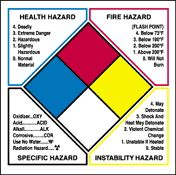 |
 |
| MSDS Topics |
Free Sites | FAQ's | Regulations | Glossary | Software | Suppliers |
| Books | Forum | Poll | Fun stuff | Quiz | Store | |
| MSDS and safety supplies | Search ALL our MSDS info | |||||
 | |||
 |
 |
 |
|
| Title: 05/06/1986 - Criteria for severe solvent refinement under the Hazard Communication Standard. | |
| Record Type: Interpretation | Standard Number: 1910.1200 |
|
May 6, 1986
Mr. Ed Starbuck Dear Mr. Starbuck: This is in response to your letter of March 25, 1986 on the subject of criteria for severe solvent refinement under the Hazard Communication Standard. Your letter raises two issues relevant to my first letter to you on this issue, dated March 19, 1986. Your first point is that the Halder paper referenced by IARC deals only with paraffinic distillates and thus should not apply to naphthenic oils. You are correct. Our review of the relevant sources demonstrates that no evidence was present in any of the papers cited by IARC that solvent refined naphthenic oils refined at any level of severity produced carcinogenic results in animal testing. Therefore no naphthenic oil which undergoes solvent refining will be regarded by OSHA as carcinogenic under the Hazard Communication Standard until or unless some study which is designed and conducted according to established scientific principles and which reports statistically significant conclusions regarding its health effects is performed. Because there are no positive carcinogenic results for solvent refined naphthenic distillates in the papers referenced by IARC, OSHA concludes that the statement in the IARC Monograph that mildly solvent refined oils are carcinogenic to experimental animals refers to mildly solvent refined paraffinic oils for which there are data, as you acknowledge, in the Halder paper. |  Communicate workplace hazards with handy labels from Safety Emporium. |
There are two points, however, about which we believe a modification of our previous interpretation is called for, both of which refer to paraffinic oils. The Halder paper states (page 272) that solvent refining of lubricating oil distillates to produce VI's of 85-100 is sufficient to effectively eliminate dermal carcinogenic activity. However, the actual data cited in Table V of the paper shows carcinogenic activity to exist for mildly solvent refined paraffinic distillates which have not been hydrofinished when the Viscosity Index is 76. No date if presented anywhere in the paper for carcinogenicity at any higher Index. Therefore, OSHA is compelled to clarify its interpretation to consider as carcinogenic only those solvent refined paraffinic distillates whose Viscosity Index is 76 or below. The second modification concerns additives. Since Viscosity Index can be raised by additives without reducing the carcinogenicity of base oil, we are further requiring that the Viscosity Index of the base oil as it leaves the refinery stream be greater that 76 before the finished oil can be exempt from the labelling requirements of the Hazard Communication Standard.
|
Finally, with regard to your request to exempt the products of San Joaquin Refining Co., Inc. from the labelling requirement of the Hazard Communication Standard, we must again refer to IARC Monograph 33. The Monograph states that, "There is sufficient evidence for the carcinogenicity in experimental animals of untreated vacuum distillates, acid treated oils, and aromatic oils, including extracts from solvent treatment of distillates and the high boiling fraction of catalytically cracked oils (classes 1, 2, and 6)" pp. 150-151. If your products fall into one of these stated categories or any of the other categories identified by IARC as producing carcinogenic products you are required to label appropriately under the Hazard Communication Standard. If your products do not fall into any category defined by IARC as producing carcinogenic effects and there is not other experimental evidence of carcinogenicity then those products are not subject to the labelling requirements of the Standard. I hope that this information will clarify the points you raised in your letter. Sincerely, John B. Miles, Jr., Director |  Safety posters are a terrific way of reminding employees of proper procedure. Get yours at Safety Emporium. |
The official, public domain, OSHA version of this document is available at http://www.osha.gov/pls/oshaweb/owadisp.show_document?p_table=INTERPRETATIONS&p_id=19428&p_text_version=FALSE